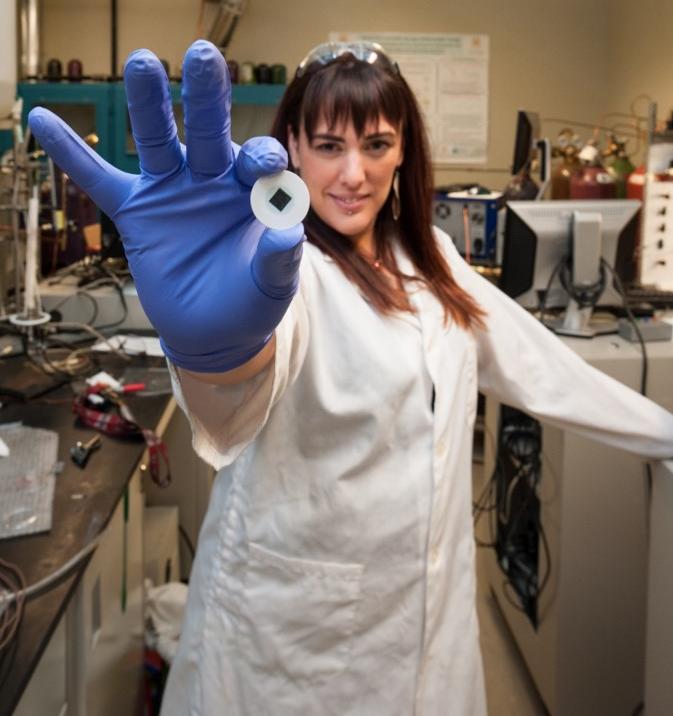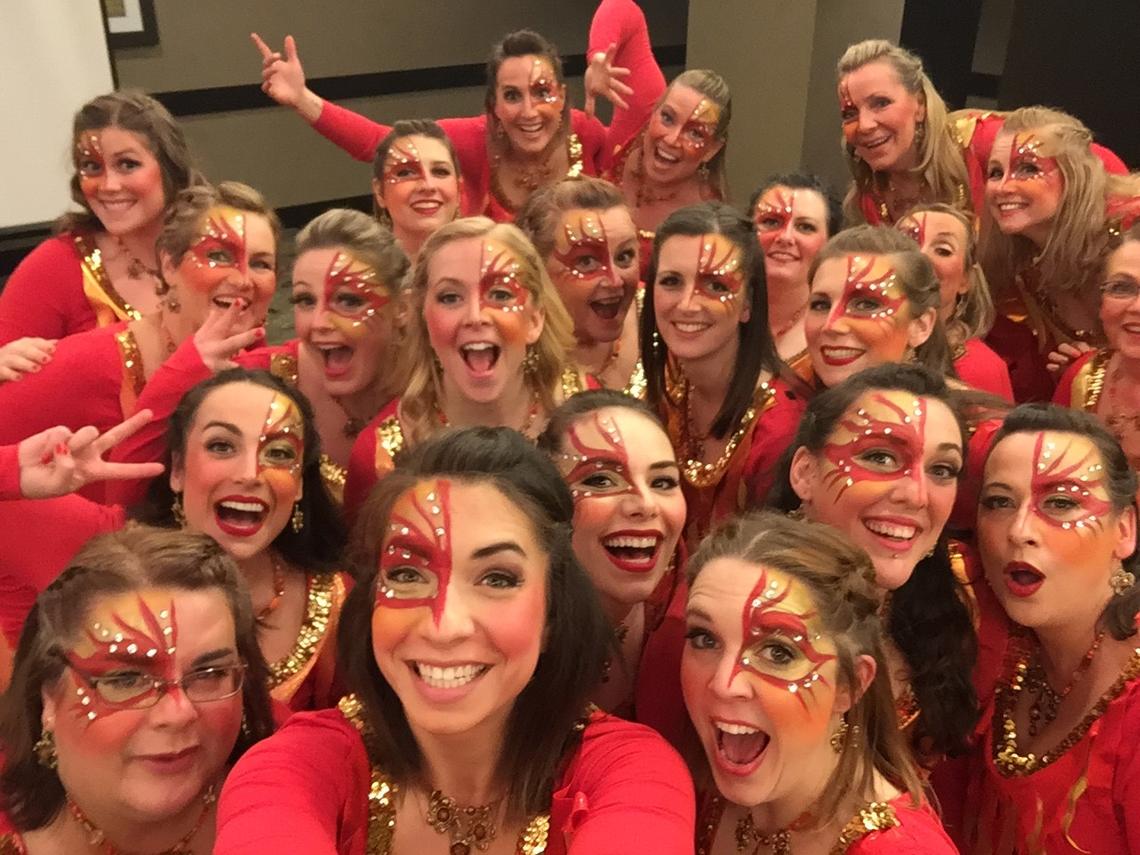
Molero holds a fuel cell, an electrochemical device that can convert chemical energy into power.
Tao Wang
Nov. 9, 2017

Molero holds a fuel cell, an electrochemical device that can convert chemical energy into power.
Tao Wang
Chemistry, clean energy, and a chorus — while one of these things isn’t quite like the others, all three of those words sum up the last six years for PhD candidate Beatriz Molero Sanchez, who is preparing to cap off six years as a student at the University of Calgary at convocation on Friday, Nov. 10.
Molero first arrived in Calgary from her native Spain after winning a highly competitive Trans-Atlantic Science Student Exchange Program in 2011. A childhood friend had been at UCalgary two years prior, and recommended it to Molero based on the excellent scholarship and research opportunities. The two had also skied together many times, so Calgary’s proximity to the Rocky Mountains sealed the deal.
Innovative approach to clean energy generates exciting opportunities
While working on her MSc degree, Molero became increasingly interested in staying at UCalgary for her PhD, rather than returning to her home university in Spain. Although her expertise was solid state chemistry at the time, she’d become interested in learning more about its applications. After meeting professor Viola Birss, who would become her supervisor, Molero was convinced UCalgary was the place for her.
“I met Viola, who is a world leader in electrochemistry and a Tier I Canada Research Chair in Fuel Cells and Related Energy Systems. Given her expertise, working with her was a great opportunity for me to move toward the applications of solid state chemistry, and most importantly, toward renewable energy sources,” Molero explains. “It’s a very exciting field to be in.”
Molero’s PhD research involved working with fuel cells, highly durable electrochemical devices that can convert chemical energy directly into power. Fuel cells can be scaled up or down as needed, and are used in devices as small as a smartphone to as large as emergency power generators for the massive data banks at Google and Microsoft. Molero works specifically with fuel cells that operate at high temperatures, and uses them reversibly — that is, systems that reversibly store and produce energy. Together with Birss and fellow PhD student Paul Addo, her research found that this has exciting implications for clean energy.
“The reversible system is very unique — there are only a few research groups in the world working on this. Our work involves operating fuel cells in the reverse mode while storing electricity and also using CO2 from the atmosphere, converting it to useful products, so you’re tackling two problems at the same time,” says Molero.
From a chemistry perspective, the electrochemical reactions that occur in the regular fuel cell mode are exothermic and spontaneous; they generate heat and power that can be used in a variety of ways. In the reverse mode, the electrochemical reactions are endothermic and non-spontaneous, so they need heat and power.
“When these cells are operated in the reverse mode, the idea is that the excess renewable energy could be used to power the fuel cell in reverse, storing that excess renewable energy in the form of useful products,” Molero says. “These devices could have an impactful contribution to the energy storage sector.”
The research is gaining traction. Birss, Molero and Addo have recently received an Idea to Innovation (I2I) Grant from NSERC. “The goal is to build a prototype, scale it up, and potentially lead it to commercialization,” she explains. “Commercializing this technology is something I’d never thought about but it is exciting and it gives you different skills, completely different from what you gain in a lab or university.”
In the near future, Molero plans to take on a postdoc position at the Massachusetts Institute of Technology (MIT) in Boston.
“It has been wonderful to have Bea as such a key player within my team,” says Birss. “She has been instrumental in expanding our international collaborations, while also now helping to move the discoveries made in her area of research into real-world application. This is especially satisfying as her work will help to accelerate the implementation of clean energy technologies and CO2 conversion to useful products, both of which are urgently needed.”

Molero (second from left, second row) pictured with the Vocal-Motion! Chorus.
Judy Garvey, Vocal-Motion!
Mountains, music, mathematics prove perfect combination
Although Molero immersed herself in her research for years, she found balance in both music and mountains, hobbies of hers since childhood.
“Towards the end of high school and beginning of undergrad, I was really getting into mountain climbing and mountaineering. In Spain, rock climbing is a very big thing. When I moved here, the Rockies were very exciting to me,” she says. A part-time job as a ski instructor at Canada Olympic Park and skiing in the nearby hills allowed her to continue enjoying the mountains and the new challenges.
She has also volunteered as a coach for confidence and physical literacy in young children, as well as in adults who are learning how to ski (including many of her fellow grad students and postdocs). In particular, she has been really enjoying coaching a women’s program to empower women who want to build confidence on skis to teach or keep up with their children.
From the age of six, Molero attended conservatory school in music for 10 years, playing piano and singing. “I would go to school, then spend an average of four hours per day in music school. I took many courses such as music theory, history of music, melodic dictation and intonation. And I discovered two important things: the first was math and the other was singing,” Molero says.
“My grandmother was an elementary school teacher and the only person in my family with musical background; she also played the piano and directed the children’s choir. Although I was quite young when she started suffering from Alzheimers, I guess I owe my passion and talent for music to her.”
Molero credits her music education with developing her scientific mind. “I was good at mathematics because I had learned all this music theory. Music is pure math — every note vibrates with a particular fundamental frequency, the intervals between them, all the tempos, all the divisions of notes, etcetera. The more you get into music at a higher level, the more you have to be really analytical and scientific about it.”
Molero confirmed her theory after moving to Calgary, when she joined the Vocal-Motion! Chorus, an award winning all-female acapella group, reminding her of her previous chorus at home where she sang for about 12 years. She quickly took on leadership roles, due to her extensive training in music theory.
“We sing barbershop songs and we also sing rock and pop songs. We’ve won the regional championships twice,” she says proudly. “We went to Las Vegas last year to represent Canada, and placed fourth in the world.”
Support from friends and colleagues defines Calgary experience
Molero’s tight-knit groups at UCalgary and in Vocal-Motion have shown up to support her in all of her important events.
“Vocal-Motion, much like my group in Spain,” Molero says, “is like a family,” and some of the members came to her final presentation for her PhD and dissertation. Birss and other members of her research group are regular fixtures at Vocal-Motion performances, and frequently tune into the live competition webcasts.
“I have met a lot of strong and very talented amazing women,” Molero says. “I’m really glad that I have Viola as a mentor. Having a woman as a mentor has been very important to me. It has allowed me to learn first-hand how things were and have or have not changed for women in science. I believe that having strong role models — both male and female — plays a crucial role in your personal and professional development.”
Says Birss, “Bea is one of those lucky people who is super multi-talented, excelling at science, research, music and sports. She will clearly be successful in whatever direction she decides to take down the road.”